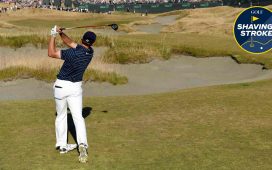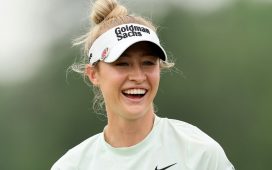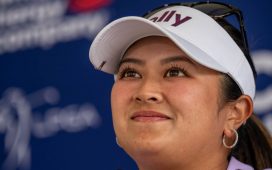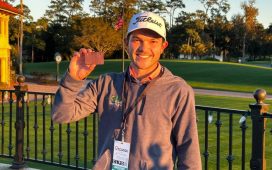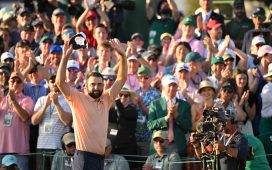SAN DIEGO – There have been a handful of accomplished U.S. Open performers over the last three decades, none more than Tiger Woods with his three wins and two seconds. In the mortals flight, there’s a pair of South Africans each with a pair of Opens: Ernie Els and Retief Goosen. Payne Stewart won two and should have won four, but the two he didn’t win went to Lee Janzen. Brooks Koepka is on that list too.
But the second greatest U.S. Open player of this generation isn’t among the aforementioned. It’s Philip Alfred Mickelson.
Before y’all run for your pitchforks, even drive-by golf fans know that Phil Mickelson has won as many U.S. Open titles as Amy Mickelson. It’s simply that his lack of a trophy is incidental to the fact that he’s been the ultimate survivor in golf’s most cutthroat test of, well, survival.
Vitas Gerulaitis delivered one of the great quips in sport more than 40 years ago when he said, “Nobody beats Vitas Gerulaitis 17 times in a row.” That was after he ended a streak of losses to Jimmy Connors. It wasn’t actually true—at the time, he had lost even more consecutive matches to Bjorn Borg—but his comment illustrated themes familiar to elite athletes: determination, hope, self-belief, frustration and futility.
Mickelson can surely relate since he first pegged it as an amateur at Medinah on June 14, 1990. He’s logged 8,032 strokes since then, 76 of which came Saturday in the third round at Torrey Pines. Short of him producing a score usually only seen in Golden Tee games, Mickelson will be 0-for-30 in this championship when he drives home tomorrow.

Phil Mickelson looks over the 5th green during the third round of the U.S. Open golf tournament at Torrey Pines Golf Course. Mandatory Credit: Michael Madrid-USA TODAY Sports
In the tradition of U.S. Opens, this has been a week that exposes the Achilles of any 51-year-old golfer, even one who claimed a sixth major victory a month ago: inconsistency. On days when the longest club in his arsenal co-operated, the shortest one didn’t. If Mickelson’s first-round 75 gave him much to do, his second-round 69 gave him hope, and it’s always the hope that kills you.
“I played really well yesterday and thought I had it,” Mickelson said. “I was going to make a run, and I just completely lost it today. But I was sure appreciative of the chance to play here in a U.S. Open on a place that is special to me and I grew up playing.”
Phil has learned to search for polite positives in this event, but the flashes of brilliance that were once so frequent are now fewer and farther between.
With respect to his six majors, the U.S. Open has been the Sisyphean tale that has defined Mickelson’s career. In theory, it should have been the event least suited to his gambling, go-for-broke style. Granted, it was in that he hasn’t won it, but no one in the 121 years of this event put himself in the mix on the closing holes more often—a record six runner-up finishes and two fourths among his ten top 10s.
Above all else, the U.S. Open is designed to test resilience, the ability to take the gut punches and the crushing disappointments and the borderline malice of the setups and the near-misses and yet keep coming back for more. No one keeps coming back for more quite like Mickelson.
For 30 years he has waged a silent psychological war with the USGA. It spilled over only once, when he petulantly hit a moving ball at Shinnecock Hills in ’18, a moment that seemed to signal a realization that the only missing major would always elude him. That’s partly because the burden of expectation he bears at the U.S. Open is intensified at venues like Shinnecock Hills. He has played so well for so long at so many courses that there will always be some straws for his true believers to cling to.
The fact that he has played well at Torrey Pines gave voice to his choir this week, no matter that his last win was 20 years ago. Same story last year at Winged Foot, where his final-hole theatrics cost him in ’06. And two years back at Pebble Beach, where he won the regular PGA Tour stop five times, including just four months before that Open. So too in that Shinnecock Hills edition, where fans eagerly noted that he’d finished top 4 in the two previous Opens there. Well so had Jeff Maggert, and he wasn’t winning in ’18 either.
Through it all, Mickelson soldiered on. His PGA Championship win exempts him into the next five U.S. Opens, but upcoming venues like The Country Club and Los Angeles CC aren’t imbued with much history for him. The next Pinehurst staging will conclude on his 54th birthday, a coincidence sure to have sentimentalists drooling and dreaming. His exemption likely expires at Oakmont, where Arnold Palmer bade farewell in 1994. If you’re a swashbuckling superstar who has had his heart regularly broken in the Open, there’s no more apropos exit ramp.
The odds of Mickelson winning one of these now seems so slender as to be preposterous. U.S. Open golf typically prizes execution, not the imagination that carried him at Kiawah Island last month. He hasn’t given up though, even 30 years on. After that 76 Saturday, he went right to the range.
“I’ll come out tomorrow and do the best I can,” he said.
The 121st U.S. Open did to Mickelson exactly what it has done 29 times before: probe his nerve, frustrate his mind, expose his swing, break his heart. And yet he’ll be back tomorrow. And next year. Woods is the greatest U.S. Open player of our era, but when it comes to the resilience that is the defining characteristic of this championship, there has been no finer exemplar than Mickelson. Even if they never did give him a trophy for it.
